April showers bring May … sours?
Patio season is fast approaching, and with it returns the oft sessionable, refreshing sour beer season. Tart beers have risen in popularity in recent years, and craft breweries have knuckled down on the pucker to showcase the style’s complexity. As with many beer styles, sours are more than meets the tongue.
Sours: A Brief, Bitter History
Like many beer styles, the history of sours begins before the advent of refrigeration and modern sanitation. Belgian monks would brew beer in open air, creating a veritable honey pot for natural bacteria like Lactobacillus and Pediococcus. These bacteria produced funky aromas and tart flavors, and led some to refer to the sour beers as “horse blanket” beer.
Belgian sour beers – especially the lambic style – made their way to the United States in the 1970s. Lambics – like champagne in the wine world – are a country-specific style. Their wild yeast and bacteria are native to the Zenne region of Belgium in Brussels. Lambic is an umbrella term, encompassing several more-specific beer styles like a fruited-lambic or the gueuze (pronounced “goo-zzz”), which is made of blended lambics of various ages.
American brewers caught the “bug,” intentionally introducing bacteria and wild yeast into beers to produce similar tart, complex beers.
A Geographical Tour Of Sour Beer History
Lambics may be the backbone of sour beers, but German and American craft breweries offer other tasty variations.
Truly, what makes a sour is the intentional introduction of bacteria or souring strains of yeast to produce a complex and tart craft beverage.
In Germany, the gose and Berliner Weisse are two popular and historical sour styles. The gose (pronounced “goes-eh”) is a crushable, slightly sour ale, first brewed in the 13th Century in Goslar, Germany. Its most distinguishing flavor, when compared to other sours, is salt. It may also boast light lemon, coriander, and other herbal characteristics.
The Berliner Weisse is a cloudy, wheat ale, which is low in alcohol, and features a unique lactic acid taste. Traditional Berliner Weisses can also be served with syrup, usually raspberry or woodruff. It sweetens the deal and beertenders add it directly to the glass after pouring the beer.
In recent years, American craft breweries have taken sours to levels likely unforeseen by early European brewers. Smoothie and heavily fruited sours are wildly popular styles in the United States. As the names suggest, they feature massive additions of fruit puree, juice or extract, and, sometimes, lactose. The end result is often reminiscent of fruit smoothies: creamy, soft, and a see-saw experience of sweetness and tartness. Unlike the lighter German versions, heavily-fruited sours can pack a punch, with alcoholic content of 7% ABV or higher.
Sour Glossary: Smoothie Sours vs Wild Ales vs Other Sours
You’ll see sour beers labeled a myriad of ways, and it can be confusing. Here’s a run down of what you can expect from various sour style labels.
Wild Ale: Typically thin and astringently tart. This is an official style of beer by the Beer Judge Certification Program (BJCP). Despite the name, it does not mean these beers are spontaneously-fermented; rather, it indicates they are influenced by microbes other than traditional brewer’s yeast.
Spontaneous Fermentation: Often considered a Wild Ale. Brewers will label their bottles as “spontaneously fermented” to better communicate that it was fermented with bacteria and yeast in the open air – often through the use of coolship. This too is often thin and astringently tart, but not always.
Smoothie Style: Typically quite thick and more sweet than tart. Brewers add a ton of viscous fruit puree to the mix near the end of the beer-making process. It should remind you of a fruit smoothie or shake. TIP: Gently roll the can before opening or tilt it on its head briefly, to ensure the fruit is evenly mixed up in the beer.
Over-Fruited: Thickness varies, but often these styles tend to be a little more thick with an equal blend of sweetness and tartness, typically made with a combination of fruit juice and fruit puree.
Fruited: Usually more on the thin and slightly tart side. These may be fruited with puree, fruit extract, fruit juice or raw, whole fruit.
Kettle Sour: This is not technically a beer style, but rather a brewing technique. Kettle sours, also known as “quick sours,” are soured in a stainless steel mash ton – the “kettle” – then fermented in another steel tank rather than a barrel where it would traditionally get its sour notes from.
So turn that tart frown upside-down and un-pucker your lips. Whether it’s a classic sour style inspired by German brewers of old or a newly stuffed and sumptuous smoothie style, there’s a sour beer for almost everyone.
Local Craft Breweries Master The Sour Style
It’s nearly impossible to visit local craft breweries and not find a sour beer, and we feature many of them in our reach-in cooler and on tap.
- G-Five Brewing (Beloit, WI) teamed up with us at Garth’s Brew Bar to brew Bramble Brawl, featuring strawberry, blackberry, raspberry, and blueberry. There’s also a hint of cinnamon and vanilla to mellow out the pucker. It’s a crushable 5% ABV and pours a hazy purple color. G-Five also brews a flagship kettle sour called Tiny Crown, which boasts blueberry, honey, vanilla, and lavender.
- The “POG”, or Passionfruit Orange Guava, is a common fruited-sour style. Sahale Ale Works (Grafton, WI) brews a Hawaiian Shaved Ice variation of the POG, which pours hazy light orange and clocks in at a more boozy 7.5% ABV.
- Delta Beer Lab (Madison, WI) brews KSR.01, their flagship kettle sour. They have several fruited versions, like the mango KSR.03 and strawberry rhubarb KSR.05. Brewed in a traditional sense, they register at a sessionable 4.4% ABV.
- Destihl Brewing (Normal, IL) crafts a similarly light, Leipzig-style gose in their mainstay Wild Sour series. It started as a classic gose – Here Gose Nothin’ – but they’ve branched out into lightly fruited versions like peach cobbler and key lime.
- Untitled Art (Waunakee, WI) has countless fruited styles. Perhaps the most distinguishable is their Lychee Sherbet. Lychee is a rare find in American fruited beers. It’s a cherry-esque fruit native to southern China, and is part of the soapberry family because, obviously, it’s typically used in soaps. The Berlinner-style Lychee Sherbet is a lightweight 4.5% ABV.
- Eagle Park Brewing Company (Muskego, WI) has dove deep into heavily-fruited variations with their flagship Slush series. They’ve brewed it with a wild spectrum of fruits, including pineapple, mango, orange, “rocket pop”, and strawberry. At 8% ABV, they’re heavyweights compared to traditional Belgian and German styles.
- Drekker Brewing (Fargo, ND) also packs a fruity punch with their flagship smoothie sour Braaaaaaaains series, where the can art features a skull overflowing with thick slushie mix. Their most recent addition to that lineup is Slushy XL, because of course it is. Brewed in collaboration with 450 North (Columbus, IN), it’s 6.9% ABV and chock-full of blueberry, banana, kiwi, and guava.


3 comments
Scott
June 3, 2022 at 1:05 pm
Thanks!
How do Kettle Sours fit with the definitions above?
Also, seems the New Glarus sour program deserves a mention. And maybe O’so too…
cheers!
Garth's Brew Bar
June 23, 2022 at 5:53 pm
That’s an awesome question! We just added a bullet for kettle sours specifically. In short – they’re typically more on the tart side! And yes, there are so many fantastic Wisconsin breweries with meaningful sour programs. We love it!
Pingback: Craft Beer Style Trends To Seek Out In Garth’s Brew Bar’s Craft Beer Cooler – Garth's Brew Bar